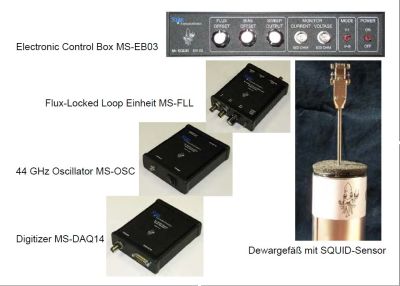Flux quantization in superconducting rings: experiments with a DC-SQUID
Supervisor: M. Sc. D. Reinhardt
Superconductor have below a critical temperature (transition temperature) a
negligible electrical resistance and allow so almost lossless current conduction.
Superconductivity is a quantum mechanical state.
Model descriptions based upon paired electrons (Cooper pairs), which obey the Bose-Einstein statistics.
Experiments are performed under the use of a DC SQUID (direct current - superconducting
Quantum interference device), consisting from a YBaCuO thin-film structure.
For this high temperature superconducting compound oxide is
the superconducting Critical temperature above 77 K and a cooling with liquid nitrogen is sufficient:
(a)
Voltage-current measurements at a DC-SQUID, determination of the critical current,
determination of Resistance in the normal state, determining the characteristic Voltage.
(b)
Shapiro-step measurement (V-I measurement with microwave coupling), determination
of the fundamental constant e / h from the measurements.
(c)
Voltage-Flux Characterization, flux-locked loop measurements, determination of the
maximum voltage modulation of a flux quantum, flux quantization in
superconducting rings, to determine the relationship between output voltage
and the magnetic flux (SQUID as a highly sensitive magnetic field sensor).

